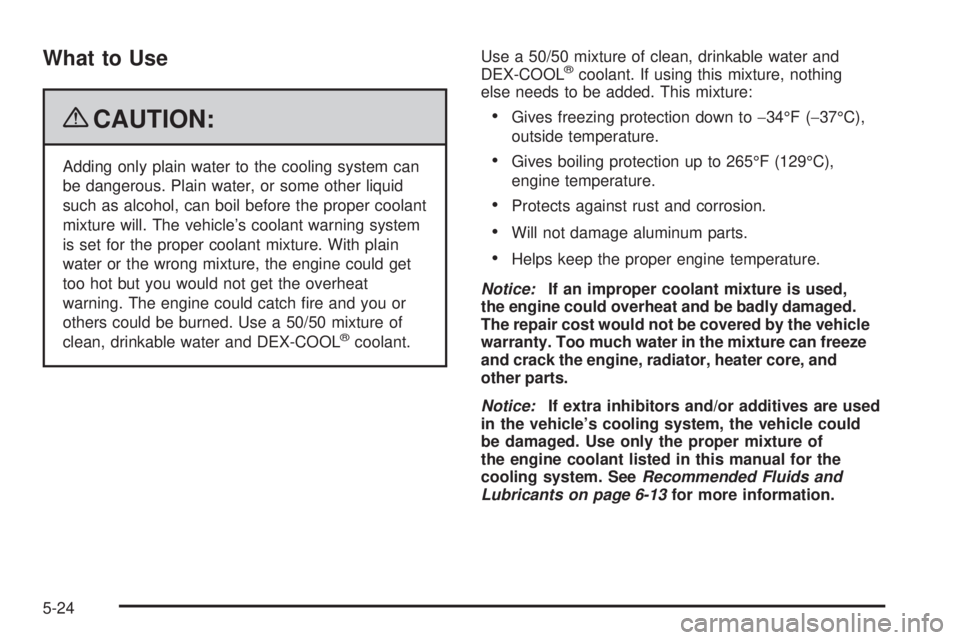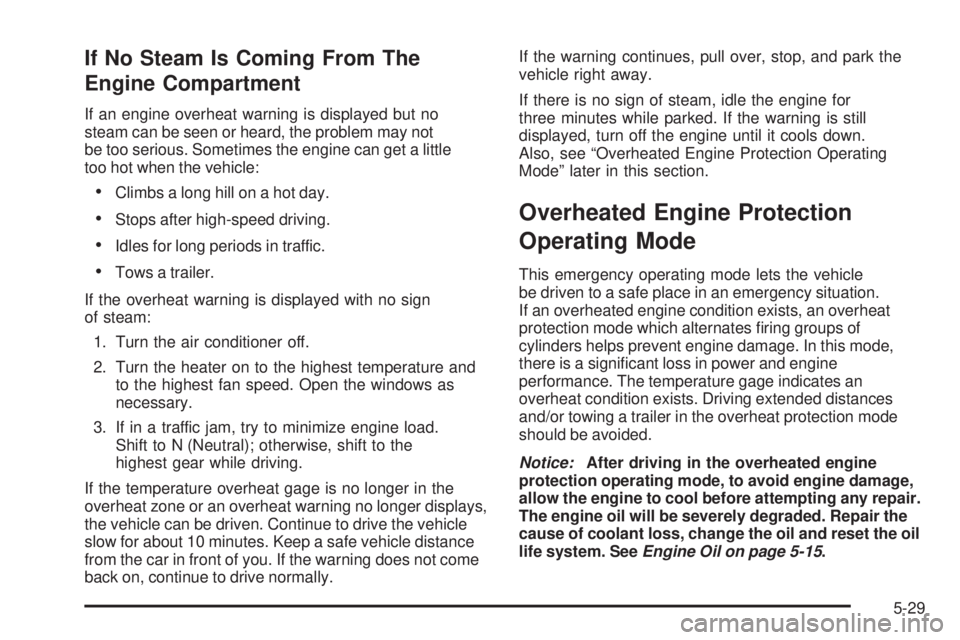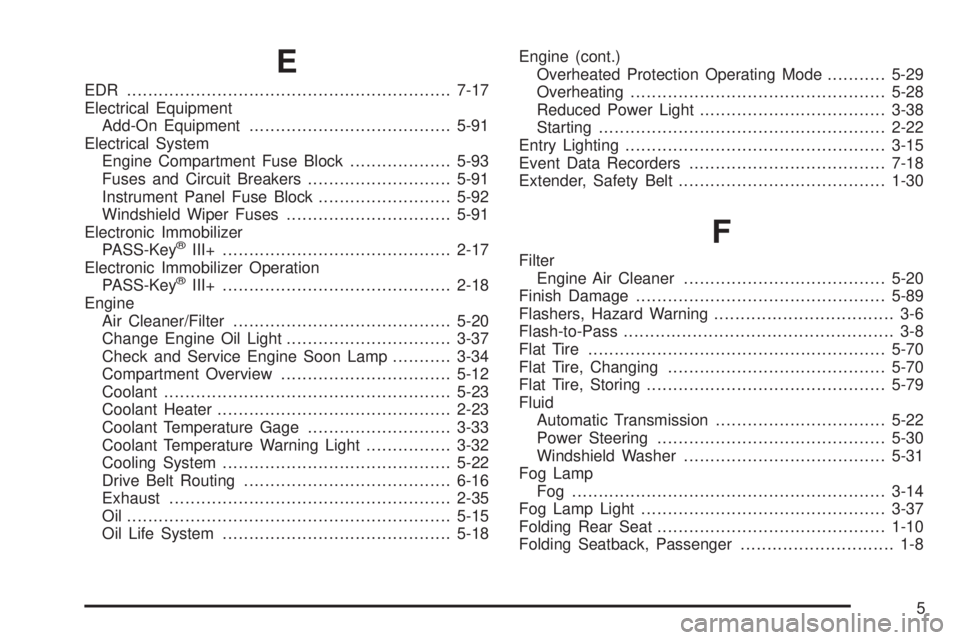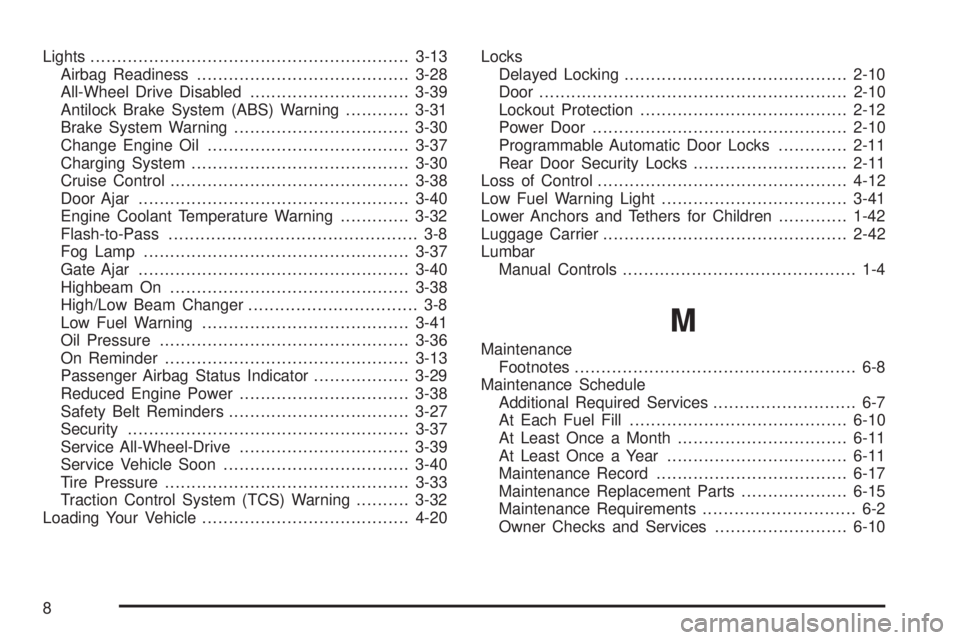2009 PONTIAC TORRENT oil temperature
[x] Cancel search: oil temperaturePage 308 of 436

What to Use
{CAUTION:
Adding only plain water to the cooling system can
be dangerous. Plain water, or some other liquid
such as alcohol, can boil before the proper coolant
mixture will. The vehicle’s coolant warning system
is set for the proper coolant mixture. With plain
water or the wrong mixture, the engine could get
too hot but you would not get the overheat
warning. The engine could catch �re and you or
others could be burned. Use a 50/50 mixture of
clean, drinkable water and DEX-COOL
®coolant.Use a 50/50 mixture of clean, drinkable water and
DEX-COOL
®coolant. If using this mixture, nothing
else needs to be added. This mixture:
Gives freezing protection down to−34°F (−37°C),
outside temperature.
Gives boiling protection up to 265°F (129°C),
engine temperature.
Protects against rust and corrosion.
Will not damage aluminum parts.
Helps keep the proper engine temperature.
Notice:If an improper coolant mixture is used,
the engine could overheat and be badly damaged.
The repair cost would not be covered by the vehicle
warranty. Too much water in the mixture can freeze
and crack the engine, radiator, heater core, and
other parts.
Notice:If extra inhibitors and/or additives are used
in the vehicle’s cooling system, the vehicle could
be damaged. Use only the proper mixture of
the engine coolant listed in this manual for the
cooling system. SeeRecommended Fluids and
Lubricants on page 6-13for more information.
5-24
Page 313 of 436

If No Steam Is Coming From The
Engine Compartment
If an engine overheat warning is displayed but no
steam can be seen or heard, the problem may not
be too serious. Sometimes the engine can get a little
too hot when the vehicle:
Climbs a long hill on a hot day.
Stops after high-speed driving.
Idles for long periods in traffic.
Tows a trailer.
If the overheat warning is displayed with no sign
of steam:
1. Turn the air conditioner off.
2. Turn the heater on to the highest temperature and
to the highest fan speed. Open the windows as
necessary.
3. If in a traffic jam, try to minimize engine load.
Shift to N (Neutral); otherwise, shift to the
highest gear while driving.
If the temperature overheat gage is no longer in the
overheat zone or an overheat warning no longer displays,
the vehicle can be driven. Continue to drive the vehicle
slow for about 10 minutes. Keep a safe vehicle distance
from the car in front of you. If the warning does not come
back on, continue to drive normally.If the warning continues, pull over, stop, and park the
vehicle right away.
If there is no sign of steam, idle the engine for
three minutes while parked. If the warning is still
displayed, turn off the engine until it cools down.
Also, see “Overheated Engine Protection Operating
Mode” later in this section.
Overheated Engine Protection
Operating Mode
This emergency operating mode lets the vehicle
be driven to a safe place in an emergency situation.
If an overheated engine condition exists, an overheat
protection mode which alternates �ring groups of
cylinders helps prevent engine damage. In this mode,
there is a signi�cant loss in power and engine
performance. The temperature gage indicates an
overheat condition exists. Driving extended distances
and/or towing a trailer in the overheat protection mode
should be avoided.
Notice:After driving in the overheated engine
protection operating mode, to avoid engine damage,
allow the engine to cool before attempting any repair.
The engine oil will be severely degraded. Repair the
cause of coolant loss, change the oil and reset the oil
life system. SeeEngine Oil on page 5-15.
5-29
Page 392 of 436

(k)A fluid loss in any vehicle system could indicate a
problem. Have the system inspected and repaired
and the fluid level checked. Add fluid if needed.
(l)If driving regularly under dusty conditions, inspect the
filter at each engine oil change.
(m)Visually inspect belt for fraying, excessive cracks, or
obvious damage. Replace belt if necessary.
(n)Severe service is when the vehicle is mainly driven
under one or more of these conditions:
�In heavy city traffic where the outside temperature
regularly reaches 90°F (32°C) or higher.
�In hilly or mountainous terrain.
�When doing frequent trailer towing.
�Uses such as found in taxi, police, or delivery
service.
(o)Change the fluid the first time the vehicle is serviced
after 100,000 miles (166 000 km) and when the
vehicle is serviced after each subsequent 50,000 miles
(83 000 km).Owner Checks and Services
These owner checks and services should be performed
at the intervals speci�ed to help ensure vehicle safety,
dependability, and emission control performance. Your
dealer/retailer can assist with these checks and services.
Be sure any necessary repairs are completed at once.
Whenever any �uids or lubricants are added to the
vehicle, make sure they are the proper ones, as shown
inRecommended Fluids and Lubricants on page 6-13.
At Each Fuel Fill
It is important to perform these underhood checks at
each fuel fill.
Engine Oil Level Check
Notice:It is important to check the engine oil
regularly and keep it at the proper level. Failure to
keep the engine oil at the proper level can cause
damage to the engine not covered by the vehicle
warranty.
Check the engine oil level and add the proper oil if
necessary. SeeEngine Oil on page 5-15.
6-10
Page 427 of 436

E
EDR .............................................................7-17
Electrical Equipment
Add-On Equipment......................................5-91
Electrical System
Engine Compartment Fuse Block...................5-93
Fuses and Circuit Breakers...........................5-91
Instrument Panel Fuse Block.........................5-92
Windshield Wiper Fuses...............................5-91
Electronic Immobilizer
PASS-Key
®III+...........................................2-17
Electronic Immobilizer Operation
PASS-Key
®III+...........................................2-18
Engine
Air Cleaner/Filter.........................................5-20
Change Engine Oil Light...............................3-37
Check and Service Engine Soon Lamp...........3-34
Compartment Overview................................5-12
Coolant......................................................5-23
Coolant Heater............................................2-23
Coolant Temperature Gage...........................3-33
Coolant Temperature Warning Light................3-32
Cooling System...........................................5-22
Drive Belt Routing.......................................6-16
Exhaust.....................................................2-35
Oil .............................................................5-15
Oil Life System...........................................5-18Engine (cont.)
Overheated Protection Operating Mode...........5-29
Overheating................................................5-28
Reduced Power Light...................................3-38
Starting......................................................2-22
Entry Lighting.................................................3-15
Event Data Recorders.....................................7-18
Extender, Safety Belt.......................................1-30
F
Filter
Engine Air Cleaner......................................5-20
Finish Damage...............................................5-89
Flashers, Hazard Warning.................................. 3-6
Flash-to-Pass................................................... 3-8
Flat Tire........................................................5-70
Flat Tire, Changing.........................................5-70
Flat Tire, Storing.............................................5-79
Fluid
Automatic Transmission................................5-22
Power Steering...........................................5-30
Windshield Washer......................................5-31
Fog Lamp
Fog ...........................................................3-14
Fog Lamp Light..............................................3-37
Folding Rear Seat...........................................1-10
Folding Seatback, Passenger............................. 1-8
5
Page 430 of 436

Lights............................................................3-13
Airbag Readiness........................................3-28
All-Wheel Drive Disabled..............................3-39
Antilock Brake System (ABS) Warning............3-31
Brake System Warning.................................3-30
Change Engine Oil......................................3-37
Charging System.........................................3-30
Cruise Control.............................................3-38
Door Ajar...................................................3-40
Engine Coolant Temperature Warning.............3-32
Flash-to-Pass............................................... 3-8
Fog Lamp ..................................................3-37
Gate Ajar...................................................3-40
Highbeam On.............................................3-38
High/Low Beam Changer................................ 3-8
Low Fuel Warning.......................................3-41
Oil Pressure...............................................3-36
On Reminder..............................................3-13
Passenger Airbag Status Indicator..................3-29
Reduced Engine Power................................3-38
Safety Belt Reminders..................................3-27
Security.....................................................3-37
Service All-Wheel-Drive................................3-39
Service Vehicle Soon...................................3-40
Tire Pressure..............................................3-33
Traction Control System (TCS) Warning..........3-32
Loading Your Vehicle.......................................4-20Locks
Delayed Locking..........................................2-10
Door ..........................................................2-10
Lockout Protection.......................................2-12
Power Door................................................2-10
Programmable Automatic Door Locks.............2-11
Rear Door Security Locks.............................2-11
Loss of Control...............................................4-12
Low Fuel Warning Light...................................
3-41
Lower Anchors and Tethers for Children.............1-42
Luggage Carrier..............................................2-42
Lumbar
Manual Controls............................................ 1-4
M
Maintenance
Footnotes..................................................... 6-8
Maintenance Schedule
Additional Required Services........................... 6-7
At Each Fuel Fill.........................................6-10
At Least Once a Month................................6-11
At Least Once a Year..................................6-11
Maintenance Record....................................6-17
Maintenance Replacement Parts....................6-15
Maintenance Requirements............................. 6-2
Owner Checks and Services.........................6-10
8